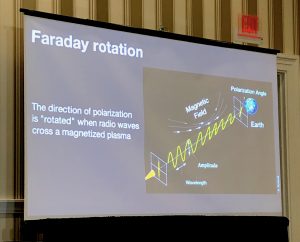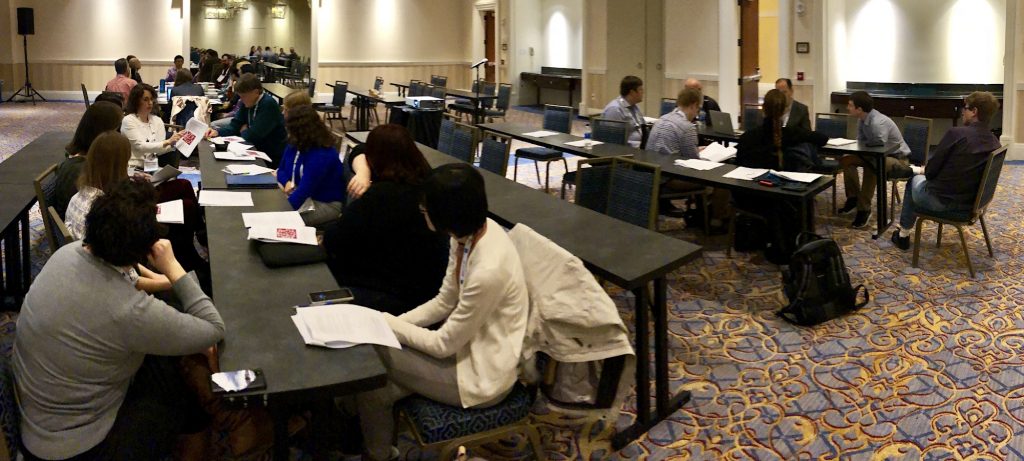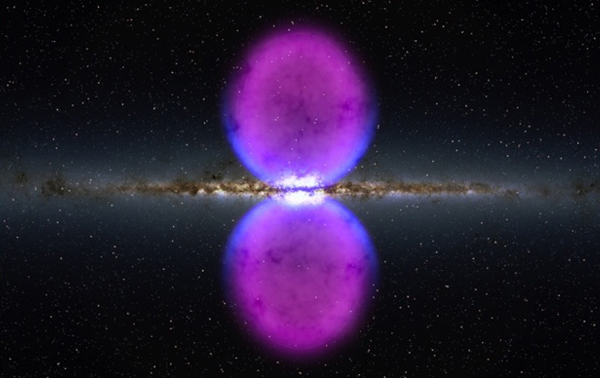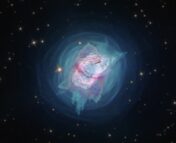Welcome to the winter American Astronomical Society (AAS) meeting in National Harbor, Maryland! Astrobites is attending the conference as usual, and we will report highlights from each day here. If you’d like to see more timely updates during the day, we encourage you to search the #aas231 hashtag on twitter. We’ll be posting once a day during the meeting, so be sure to visit the site often to catch all the news!
Plenary Talk: Unveiling the Low Surface Brightness Stellar Peripheries of Galaxies (by Nora Shipp)
Annette Ferguson (University of Edinburgh) gave an exciting plenary talk on her work toward using the faint outskirts of galaxies to better understand the origin and evolution of galaxies. She demonstrated how the old, metal-poor stars that show up in deep images of the peripheries of galaxies can tell us a lot about how the galaxy has evolved over time — and particularly about how the stellar mass of a galaxy increases via mergers and accretion.
https://twitter.com/KarenLMasters/status/951085576530350080
As an example, she described her work toward discovering that the halo of our neighbor, M31, is dominated by a larger stellar stream — the tidal remnant of a dwarf galaxy. First, Ferguson and her group observed individual resolved stars in the halo of M31 with the PAndAs survey and found two distinct stellar populations — one larger metal-rich stellar population, and one smaller metal-poor population. With follow-up observations by the Hubble Space Telescope, they were able to decipher even more about the stellar populations and found that the metal-rich stars were all quite old and that star formation must have been cut off around 5 billion years ago. Meanwhile, the metal-poor stars were much younger, and seemed to come from a population with ongoing star formation. Taking into account the spatial distributions, they determined that the dominant metal-rich stars had joined M31 as part of a dwarf galaxy that had since been torn apart into a stellar stream, and that the metal-poor stars had been pulled off of the star-forming stellar disk.
Ferguson has been able to form an interesting picture of how stellar mass has been accreted onto M31 by observations of these faint stars in the outskirts of the galaxy, and she explained that she is excited to expand this work to more galaxies at even larger distances by taking advantage of future surveys like Euclid and LSST.
Press Conference: Peering Deeper into the Lair of the Repeating Fast Radio Burst (by Susanna Kohler)
Today’s press conference contained results embargoed until this afternoon, so we had to impatiently hold off on live-tweeting the session! This conference’s topic was the unusual fast radio burst FRB 121102, a mysterious burst of radio emission that recently gained fame by being the only FRB to repeat — and by being kind enough to repeat often, so we were able to pinpoint the host galaxy of an FRB for the first time.
First press conference of the day on fast radio bursts! We won’t be live-tweeting, though, because the results are under embargo until 1pm this afternoon. #aas231 pic.twitter.com/vVvUUjTxCG
— astrobites (@astrobites) January 10, 2018
Betsey Adams (ASTRON) kicked the session off with an overview of FRBs (and FRB 121102 in particular). FRBs are millisecond bursts of radio waves that are usually one-off events. We know that they originate from outside our own galaxy, but we don’t yet know what causes these intense flashes of light. The fact that FRB 121102 repeats is interesting because this narrows down its source — it can’t be caused by an explosion, because, as Adams pointed out, “You can’t explode your source, then explode it again.”
Repeated studies of FRB 121102 have allowed us to determine its host galaxy and find a persistent radio source associated with the bursts. Its home is a star-forming dwarf galaxy located 3 billion light-years away — suggesting a connection between FRBs and massive star formation and death. Now we’re using targeted, deep follow-up observations of FRB 121102 to probe the local environment around it.Andrew Seymour (Arecibo Observatory) talked with us about the new features that we’re seeing within the bursts themselves: the emission isn’t steady over the millisecond period of the bursts, but instead exhibits brief hiccups. The team showed us some awesome 3D-printed models of the emission pulse so we could actually visualize the brief pauses and other substructure of the emission. What causes this structure? Is it something about the emission mechanism, or is it caused by how the burst interacts with its environment? Answering this may help us to figure out the origin of FRBs.
Next up, Vishal Gajjar (University of California, Berkeley) presented on efforts from the Breakthrough Listen project to learn about the highest-frequency components of these bursts. Seeing burst variation on timescales as short as 30 microseconds is an important clue: it tells us that the size of the emission region must be smaller than 10 km. Astronomically speaking, this is a tiny area — which significantly narrows down the types of sources that might be causing FRBs!

FRB 121102 exhibits unusually high levels of Faraday rotation, even compared to other FRBs. [Daniele Michilli]
Finally, Jason Hessels (ASTRON / University of Amsterdam) closed the session by summarizing what we’ve learned about FRB 121102 so far and outlining a few potential models for its origin. A neutron-star source fits many observed properties but leaves us wondering at its surprising energetics. The source could be a massive black hole — but do we really expect to see such massive black holes in small dwarf galaxies like FRB 121102’s host? A powerful nebula is another possibility, but FRB 121102 is a million times brighter than even the Crab nebula. All models we’ve come up so far have their challenges! Luckily we’ll have more help exploring FRBs in the future: upcoming observatories like CHIME (Canada), ASKAP (Australia), UTMOST (Australia), and APERTIF (Netherlands) will help us to hunt for many more such bursts. Hopefully we’ll soon better understand these mysterious sources!
A press release from this conference can be found here.
Plenary Talk: The Stormy Life of Galaxy Clusters (by Kerry Hensley)
There’s more to galaxy clusters than the galaxies themselves. In his plenary session, Larry Rudnick of the Minnesota Institute for Astrophysics explained how our understanding of cluster galaxies and the stuff between them — the intracluster medium (ICM) — has evolved. (Interestingly, Dr. Rudnick traced the discovery of the first galaxy cluster to a drawing of what is now known as the Coma cluster by Max Wolf in 1902 — even before the so-called “spiral nebulae” were recognized as galaxies separate from our own!) The ICM is a turbulent mixture of hot plasma, cosmic rays, and magnetic fields, which is heated by mergers, outflows from galaxies, and feedback from active galactic nuclei (AGN).
During cluster mergers, the entire ICM is perturbed, resulting in turbulence and shocks, both of which generate non-thermal emission. In the X-ray, this non-thermal emission can be drowned out by the thermal emission because the ICM is so hot. However, there is very little thermal emission in the radio, so the structure of the ICM is revealed at the longer wavelengths. What do halos, relics, and phoenixes all have in common? They’re all ICM structures that can be seen in the radio! These structures are tied to ongoing questions about the ICM: How do magnetic fields in the ICM get amplified? How do some particles end up a hundred million times more energetic than others? Why do X-ray and radio observations sometimes yield conflicting results for the strength of shocks in the ICM?

The galaxy cluster Abell 2256 as seen in X-ray (left) and radio (right). [X-ray image from ROSAT/Max Planck Institute. Radio image from LOFAR/Reinout van Weeren]
Want to learn more about Dr. Rudnick and his work? Check out his interview with Astrobiter Amber Hornsby!
Workshop: Astrobites in the Classroom (by Nathan Sanders)
For the second year in a row, Astrobites organized a workshop at the AAS meeting for educators to discuss how to introduce modern research into undergraduate and graduate classrooms using our site as a resource. Since our workshop last year, we have published a series of lesson-plan templates that outline specific ideas for integrating Astrobites into curricula, and this year we have developed additional ‘ready-to-use’ lesson plans that provide concrete example lessons based on these templates.
We had a great discussion with the dozens of attendees who joined the session. One of the most important outcomes for us was the educators’ detailed feedback on how to adapt our lesson-plan concepts to different teaching environments, and what additional materials we can provide to help more educators make use of them. These extensions will be our top priority in the coming months.
Thanks to a grant from the AAS Education & Professional Development division, we were able to offer this workshop free of charge and we will also be following up with the educators who participated to gather their feedback as they execute the lesson plans in their classes. We are also seeking to conduct an education research study to measure the student impacts of exposure to current research using Astrobites.
If you are an educator seeking to use Astrobites in your classroom, if you would like to be part of our panel of educators providing feedback, or have any other questions or comments, please reach out to us at [email protected]!

Attendees brainstorm at the workshop on introducing current research into your classroom with Astrobites.
Press Conference: From Comets to Galaxies (by Chris Lovell)
In this conference we cover the whole range of astrophysical scales, from spinning comets passing close to the Earth to spinning galaxies just a few hundred million years after the Big Bang. Unfortunately we couldn’t live feed this press conference as a couple of the talks — due to be released in Nature — were embargoed until after the session ended, but here’s a summary of what went down.
Dennis Bodewits (University of Maryland) presented new observations of 41P/Tuttle-Giacobini-Kresak, a small comet first discovered in 1858 that passed close to the Earth in 2017. Observing with both the Discovery Channel Telescope (DCT) on the ground, and the UltraViolet-Optical Telescope (UVOT) on the Swift space telescope, they measured the rotation of the comet in April and found a period of 20 hours. By May this had slowed to 46–60 hours, the most rapid increase in rotation period of a comet ever observed. A potential cause for this rapid slow down are huge ejections of gas from the nucleus of the comet, which are particularly pronounced on 41P.
Next up, Paul Hertz (NASA, director of Astrophysics) made a special announcement regarding the Swift telescope, a gamma-ray space observatory that has been responsible for a range or groundbreaking discoveries, most recently catching the UV emission from the neutron-star collision gravitational-wave event. The principal investigator of the Swift mission, Neil Gehrels, passed away in February 2017, and in honour of his contributions to the mission it has been renamed the “Neil Gehrels Swift Observatory”.
Both above and below the plane of the Milky Way, two giant lobes of X-ray and gamma-ray radiation are visible, known as the Fermi bubbles. These huge structures are thought to be due to ejecta from the supermassive black hole at the center of our galaxy — but until now, measuring the velocity of the material in the bubbles has been very difficult. Jay Lockman (National Radio Astronomy Observatory) presented observations of hydrogen clouds within the Fermi bubbles that are moving at incredible speeds of up to 400 kilometers per second — faster than anything else seen in the Milky Way. The clouds appear to be moving outwards in a cone from the center of the galaxy.

An artist’s impression of the Fermi bubbles above and below the plane of the Milky Way. [NASA’s Goddard SFC]
Finally, Renske Smit (University of Cambridge) finished the session with observations of galaxies during the epoch of reionization, some 13 billion years ago. Her team used the ALMA sub-millimeter telescope in Chile to follow up on two galaxies identified with the Hubble and Spitzer space telescopes and produce resolved maps of the gas in these galaxies. They could then measure the movement of the gas in these objects, and what they found was highly surprising — a coherent disk of gas, similar to the disk of the Milky Way. Astronomers expected galaxies at these early times to be highly chaotic, with a lumpy distribution of gas, but these observations suggest a much more stable situation.
Dannie Heineman Prize for Astrophysics: The Value of Change: Surprises and Insights in Stellar Evolution (by Susanna Kohler)
The Dannie Heineman prize is awarded to Lars Bildsten (University of California, Santa Barbara) in 2017, for “his leadership and observationally grounded theoretical modeling that has yielded fundamental insights into the physics of stellar structure and evolution, compact objects, and stellar explosions.” Despite Bildsten’s role as director of the Kavli Institute for Theoretical Physics at UCSB (read more about Bildsten in Ashley Villar’s interview), he still finds time for extensive research work in stellar evolution theory. Today he shared with us some of the latest developments in two fields of stellar research: asteroseismology and supernovae.
Bildsten: Kepler has been profound for finding planets, but it’s been equally profound for asteroseismology measurements. #aas231
— astrobites (@astrobites) January 10, 2018
Bildsten began by introducing the idea of how we can learn about stars based on their oscillations as waves bounce around inside them — the study known as asteroseismology. The theory behind this process is important for understanding what we’re seeing! Each type of wave that we observe in a distant star reveals a different kind of information. Bildsten discussed a few things we’ve discovered we can learn from various oscillation modes — such as the masses and radii of stars across the galaxy, the properties of their cores (which tells you what kinds of stars they are), and even measurements of their magnetic fields.
Lots of ways for waves to bounce around inside the star. COOL! #AAS231 pic.twitter.com/evqwTlh5o0
— Shauna Edson (@shaunaedson) January 10, 2018
Next, Bildsten shifted gears to talk about more extreme stellar variations: explosions! In the past, stellar explosions fell into two primary categories: core collapse of a massive star into a neutron star or a black hole, or a thermonuclear explosion triggered in a white dwarf. Recently, a new type of supernova has been discovered that’s significantly brighter than those two categories, earning these the name “superluminous supernovae”. Bildsten suggested that these transients might be the result of a magnetar — a highly magnetized, spinning neutron star — being born.
But now we’re seeing a new class of explosion that’s brighter. Bildsten proposes we might be seeing the birth of a magnetized neutron star. #aas231 pic.twitter.com/VmJBGMoAvw
— astrobites (@astrobites) January 10, 2018
Bildsten concluded with the sentiment that for stellar evolution studies, the future is bright. Missions like K2 and TESS will continue to fuel asteroseismology studies, and optical surveys like the Zwicky Transient Facility or the Dark Energy Survey will hunt for exploding stars and other stellar transients. Meanwhile, theory and computation will continue to push into new realms to explain our discoveries!
HEAD Bruno Rossi Prize: Gravitational-Wave Astronomy (by Susanna Kohler)
Gabriela González (Louisiana State University, Baton Rouge) and the LIGO Scientific Collaboration were awarded the 2017 HEAD Bruno Rossi prize “for the first direct detections of gravitational waves, for the discovery of merging black hole binaries, and for beginning the new era of gravitational-wave astronomy.” You can read more about González in Ashley Villar’s interview.
González opened her talk with a realization of how far the field of gravitational-wave astronomy has come in the past two years: “I used to give talks about all the things that were going to come. This is the first time I get to start a talk with the news of what has been discovered!”
Current and future gravitational-wave observatories. The more detectors, the better the localization of sources! #aas231 pic.twitter.com/gchzlKclUP
— astrobites (@astrobites) January 10, 2018
González began with an overview of the decades of theory that predicted gravitational waves and the work that went into building and improving the complex and highly sensitive LIGO and VIRGO detectors. She emphasized the collaborative nature of the field of gravitational-wave astronomy — when the first detection finally occurred in September of 2015, more than 1,000 authors were on the paper announcing it. Every one of those people was necessary for the discovery, González confirmed.
Since the first detection of gravitational waves from two black holes merging (GW150914), we’ve observed several more of these events. By the fourth one, González joked, the team was already bored: “Fine, another binary black-hole coalescence…” The next detection was anything but mundane, however: in August 2017, a chirp lasting ~100 seconds was detected. Since the previous signals had all been <2 seconds long — and longer signals indicate lower-mass objects — this new detection spurred excitement. The first binary-neutron-star merger had been seen in gravitational waves.
The amazing neutron star detection at @LIGO was almost vetoed by the automatic system because the detector experienced a glitch right as the wave came in. But someone saw the alert on their phone, observed the wave, and realized it wasn't a false positive. Whoa!! #AAS231
— Shauna Edson (@shaunaedson) January 10, 2018
The discovery of GW170817 in gravitational waves was followed by a flurry of activity as ground- and space-based telescopes around the world turned to point in the direction that the signal had come from. Their efforts were rewarded: counterparts to GW170817 were found throughout the next few days across the electromagnetic spectrum, and the source’s host galaxy was identified. These observations — which were contributed by roughly 4,000 astronomers around the world — have given us a remarkably detailed look at this merger.
https://twitter.com/astroprofhoff/status/951318591978303489
González wrapped up by describing the bounty of science we are now starting to be able to explore using our combined gravitational-wave and electromagnetic observations. In the next few years, we can expect increasing capabilities as more gravitational-wave detectors come online and their sensitivity improves. “The era of gravitational-wave astronomy is here,” says González, “and it’s here to stay.”




“What do halos, relics, and phoenixes all have in common? They’re all ICM structures that can be seen in the radio!”
What are phoenixes?
It’s my understanding that radio phoenixes are clouds of plasma that were once radio-emitting, then dimmed before being re-energized by a galaxy collision. They get their name from the fact that they appear to come back to “life” and beginning emitting radio waves after a collision. You can read more about phoenixes at this link: https://www.space.com/30820-radio-phoenix-rises-galaxy-collision-video.html